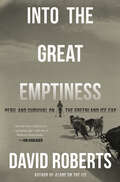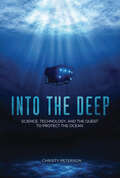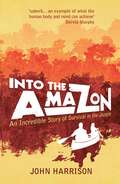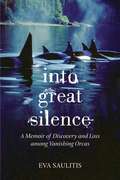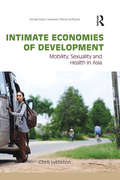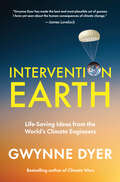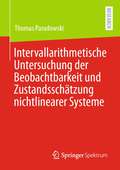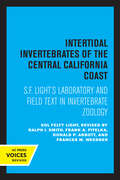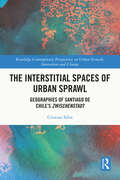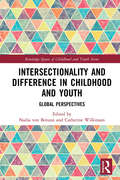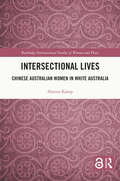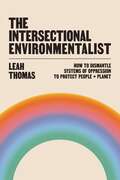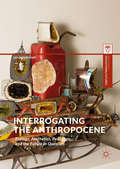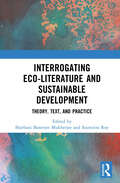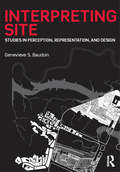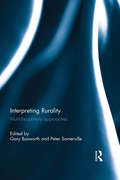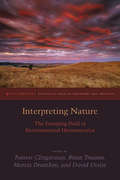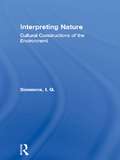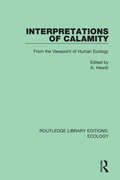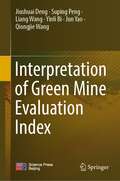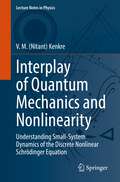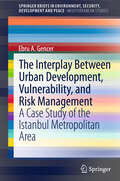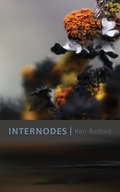- Table View
- List View
Into the Great Emptiness: Peril And Survival On The Greenland Ice Cap
by David RobertsThe riveting story of one of the greatest but least-known sagas in the history of exploration from David Roberts, the “dean of adventure writing.” By 1930, no place in the world was less well explored than Greenland. The native Inuit had occupied the relatively accessible west coast for centuries. The east coast, however, was another story. In August 1930, Henry George Watkins (nicknamed “Gino”), a twenty-three-year-old British explorer, led thirteen scientists and explorers on an ambitious expedition to the east coast of Greenland and into its vast and forbidding interior to set up a permanent meteorological base on the icecap, 8,200 feet above sea level. The Ice Cap Station was to be the anchor of a transpolar route of air travel from Europe to North America. The weather on the ice cap was appalling. Fierce storms. Temperatures plunging lower than –50° Fahrenheit in the winter. Watkins’s scheme called for rotating teams of two men each to monitor the station for two months at a time. No one had ever tried to winter over in that hostile landscape, let alone manage a weather station through twelve continuous months. Watkins was younger than anyone under his command. But he had several daring trips to the Arctic under his belt and no one doubted his judgement. The first crisis came in the fall when a snowstorm stranded a resupply mission halfway to the top for many weeks. When they arrived at the ice cap, there were not enough provisions and fuel for another two-man shift, so the station would have to be abandoned. Then team member August Courtauld made an astonishing offer. To enable the mission to go forward, he would monitor the station solo through the winter. When a team went up in March to relieve Courtauld, after weeks of brutal effort to make the 130-mile journey, they could find no trace of him or the station. By the end of March, Courtauld’s situation was desperate. He was buried under an immovable load of frozen snow and was disastrously short on supplies. On April 21, four months after Courtauld began his solitary vigil, Gino Watkins set out inland with two companions to find and rescue him. David Roberts, “veteran mountain climber and chronicler of adventures” (Washington Post), draws on firsthand accounts and archival materials to tell the story of this daring expedition and of the epic survival ordeal that ensued.
Into the Fire: The Fight to Save Fort McMurray
by Graham Hurley Jerron Hawley Steve SackettThe dramatic story of one of the biggest natural disasters in Canadian history, the Fort McMurray wildfire of 2016, told by three of the firefighters who fought to save the city. On May 1, 2016, a wildfire burning to the southwest of Fort McMurray, Alberta, led to the declaration of a local state of emergency. Two days later, the fire had reached Fort McMurray, forcing the evacuation of 88,000 citizens and destroying 2,400 buildings. In total, the fire would consume more than 500,000 hectares. Into the Fire is a remarkable first-hand account of fighting a major wildfire as it moved with terrifying speed. Over the course of six days, firefighters Jerron Hawley, Graham Hurley, and Steve Sackett of the Fort McMurray Fire Department joined local expert wildfire teams and fire departments from across the country to battle the blaze. In photographs and notes made at the time, they vividly describe what they witnessed; their own personal losses and triumphs; and the fire's devastating effects. With more than 90 stunning colour photographs, Into the Fire is a dramatic eyewitness account of one of the most catastrophic disasters in recent North American history. Intimate in its telling, it is above all a testament to the courage, pride, and extraordinary efforts of the citizens of Fort McMurray, who along with emergency personnel, came together to save their city.
Into the Deep: Science, Technology, and the Quest to Protect the Ocean
by Christy PetersonContaining 97 percent of Earth's water supply, the ocean plays a huge role in regulating global temperatures, supporting plant and animal life, and contributing to the livelihoods of millions of people. But in spite of all this, the ocean remains drastically unexplored, and the details of its impact on human lives aren't fully understood. Scientists from around the world are realizing that to address issues plaguing the ocean, such as dead zones, coral bleaching, and climate change, we need to better understand this incredible, unique feature of our planet. With a range of impressive, cutting-edge technologies at their disposal, oceanographers have set out to measure, sample, and analyze at every turn. Every day, mysteries about the ocean are being solved, and every day, new questions come to light. The more scientists learn, the better they are able to answer these new questions. What lies in the deep? And who is at the forefront of these exciting discoveries? The scientists and research included in this book shed light on the most pressing issues currently facing oceanographers and point us in the right direction to solving these challenges.
Into the Amazon: An Incredible Story of Survival in the Jungle
by John HarrisonIn 1950, a young French explorer entered deep jungle in Brazil and was never seen again. Inspired by that explorer's diary, John and Heather Harrison paddled their canoe into some of the remotest parts of the Amazon. This is the incredible story of their struggle to keep their sanity and marriage intact in one of the most hostile places on earth.
Into Great Silence: A Memoir of Discovery and Loss among Vanishing Orcas
by Eva SaulitisScience entwines with matters of the human heart as a whale researcher chronicles the lives of an endangered family of orcas Ever since Eva Saulitis began her whale research in Alaska in the 1980s, she has been drawn deeply into the lives of a single extended family of endangered orcas struggling to survive in Prince William Sound. Over the course of a decades-long career spent observing and studying these whales, and eventually coming to know them as individuals, she has, sadly, witnessed the devastation wrought by the Exxon Valdez oil spill of 1989--after which not a single calf has been born to the group. With the intellectual rigor of a scientist and the heart of a poet, Saulitis gives voice to these vital yet vanishing survivors and the place they are so loyal to. Both an elegy for one orca family and a celebration of the entire species, Into Great Silence is a moving portrait of the interconnectedness of humans with animals and place--and of the responsibility we have to protect them.From the Hardcover edition.
Intimate Economies of Development: Mobility, Sexuality and Health in Asia (Routledge Studies in Development, Mobilities and Migration)
by Chris LyttletonAspirations, desires, opportunism and exploitation are seldom considered as fundamental elements of donor-driven development as it impacts on the lives of people in poor countries. Yet, alongside structural interventions, emotional or affective engagements are central to processes of social change and the making of selves for those caught up in development’s slipstream. Intimate Economies of Development lays bare the ways that culture, sexuality and health are inevitably and inseparably linked to material economies within trajectories of modernization in the Greater Mekong Sub-region. As migration expands and opportunities proliferate throughout Asia, different cultural groups increasingly interact as a result of targeted interventions and globalising economic formations; but they do so with different capabilities and expectations. This book uniquely grounds its arguments in interlocking details of people's everyday lives and aspirations in developing Asia, while also engaging with changing social values and moral frameworks. Part and parcel of a widening landscape of mobility and contingent intimacy is the ever-present threats of infectious disease, most prominently HIV/AIDS, and human trafficking. Thus, impact assessment and targeted interventions aim to address negative consequences that frequently accompany infrastructure development and market expansion. This path-breaking book, drawn on more than 20 years of ethnographic research in the Mekong region, shows how current models of mitigation cannot adequately cope with health risks generated by wide-ranging entrepreneurialism and enduring structural violence as dreams of ‘the good life’ are relentlessly enmeshed in strategies of livelihood improvement.
Intervention Earth: Life-Saving Ideas from the World's Climate Engineers
by Gwynne DyerHistorian, journalist, and author Gwynne Dyer interviews the world&’s top 100 climate scientists to discuss the extraordinary measures we must contemplate to counter the irreversible effects of climate change.The global climate emergency is now an alarming fact of life. Much as we still need to get emissions under control, many are thinking that it's all too little, too late. As scientists, politicians and concerned citizens scramble for solutions to the catastrophic effects of a warming world, is it time to be exploring the controversial topic of geoengineering?For decades, discerning readers have turned to journalist and historian Gwynne Dyer for his unparalleled acumen in serving up hard geopolitical truths. Intervention Earth is built around Dyer&’s interviews with one hundred climate scientists from around the globe, including the leading figures in the geoengineering field. One of the most interesting topics: the pros and cons of Solar Radiation Management, a possible planetary Hail Mary that is rife with political risks.But Intervention Earth is about more than technological mega-projects. Dyer devotes ample space to the many innovative ideas on offer, but there is no get-out-of-jail-free card. We will need a whole portfolio of techniques and technologies—and a lot of hard, thankless work—to keep the planet hospitable for humanity.What&’s more, many of the technologies that can help us avoid the worst outcomes require years of investment and development before they can be successfully deployed. Global cooperation will be key in implementing the life-saving strategies outlined in the book. With up-to-the-minute, breaking-news reporting Intervention Earth offers a probing, eye-opening look at the problems we face, and the innovations that just might keep us ahead of encroaching disaster and carry us to a safe harbour.
Intervallarithmetische Untersuchung der Beobachtbarkeit und Zustandsschätzung nichtlinearer Systeme
by Thomas ParadowskiBasierend auf Methoden der Intervallarithmetik stellt Thomas Paradowski einen neuartigen Algorithmus zur Bestimmung der Beobachtbarkeit nichtlinearer zeitkontinuierlicher Systeme vor. Mittels des verwendeten Potenzreihenkalkühls werden die erforderlichen Lie-Ableitungen automatisch berechnet. Dadurch ist es möglich, nicht nur lokale Aussagen über die Beobachtbarkeit zu treffen, sondern auch globale Aussagen. Für die Fälle, in denen das nichtlineare System nicht vollständig global beobachtbar auf einem gewählten Zustandsraum ist, können jene Zustände isoliert werden, für die die Beobachtbarkeit nachweisbar ist. Ebenfalls wird eine Methode zur Zustandsschätzung von nichtlinearen Systemen mit rauschbehafteten Ausgangsmessungen präsentiert. Dabei sind entgegen anderen Methoden keine Kenntnisse zu der Art oder der maximalen Rauschamplitude erforderlich.
Intertidal Invertebrates of the Central California Coast: S.F. Light's Laboratory and Field Text in Invertebrate Zoology
by S. F. LightThis title is part of UC Press's Voices Revived program, which commemorates University of California Press’s mission to seek out and cultivate the brightest minds and give them voice, reach, and impact. Drawing on a backlist dating to 1893, Voices Revived makes high-quality, peer-reviewed scholarship accessible once again using print-on-demand technology. This title was originally published in 1954.
The Interstitial Spaces of Urban Sprawl: Geographies of Santiago de Chile’s Zwischenstadt (Routledge Contemporary Perspectives on Urban Growth, Innovation and Change)
by Cristian A. SilvaThis book proposes the idea of interstitial space as a theoretical framework to describe and understand the implications of in-between lands in urban studies and their profound transformative effects in cities and their urban character.The analysis of the interstitial spaces is structured into four themes: the conceptual grounds of interstitial spaces; the nature of interstices; the geographical scale of interstices; and the relationality of interstices. The empirical section of the book introduces seven cases that illustrate the varied nature of interstitiality to finally discuss its implications in the broader field of urban studies. Reflections upon further lines of enquiry and theories of urbanisation, urban sprawl, and cities are highlighted in the conclusion chapter. This is the ideal text for scholars of urban planning, strategic spatial planning, landscape planning, urban design, architecture, and other cognate disciplines as well as advanced students in these fields.
Intersectionality and Difference in Childhood and Youth: Global Perpsectives (Routledge Spaces of Childhood and Youth Series)
by Nadia Von Benzon Catherine WilkinsonThis book explores the alternative experiences of children and young people whose everyday lives contradict ideas and ideals of normalcy from the local to the global context. Presenting empirical research and conceptual interventions from a variety of international contexts, this book seeks to contribute to understandings of alterity, agency and everyday precarity. The young lives foregrounded in this volume include the experiences of transnational families, children in ethnic minority communities, street-living young people, disabled children, child soldiers, victims of abuse, politically active young people, working children and those engaging with alternative education. By exploring ‘other’ ways of being, doing, and thinking about childhood, this book addresses questions around what it is to be a child and what it is to be marginalised in society. The narratives explore the everydayness and the mundanity of difference as they are experienced through social structures and relationships, simultaneously recognizing and critiquing notions of agency and power. This book, including a discussion resource for teaching or peer reading groups, will appeal to academics, students and researchers across subject disciplines including Human Geography, Children’s Geography, Social Care and Childhood Studies.
Intersectional Lives: Chinese Australian Women in White Australia (Routledge International Studies of Women and Place)
by Alanna KampIntersectional Lives explores the varied experiences of Chinese Australian females across time and place during the White Australia Policy era (1901-1973). Chinese Australian women’s personal reflections are examined alongside postcolonial feminist readings of official records to illustrate how their everyday lives were influenced by multiple and fluid identities and subject positions including migrant, mother, daughter, wife, student, worker, entrepreneur and cultural custodian. This book provides new ways to conceptualise Chinese females in the diaspora as gendered, classed, culturally varied and racialised individuals with multiple forms of oppression, agency and mobility. It offers a revision of patriarchal understandings of Chinese Australian history and broader understandings of overseas Chinese migrations and settlement experiences. It also demonstrates how historical geography, informed by postcolonial feminist approaches, can facilitate more nuanced understandings of past (and present) times and places that include women’s diverse experiences at the domestic, local, national and international scale. This book will appeal to social and cultural geographers with additional audiences of interest in history and historical geography, ethnic and racial studies, gender studies, diaspora studies, migration studies, and gender and feminist studies.
The Intersectional Environmentalist: How to Dismantle Systems of Oppression to Protect People + Planet
by Leah ThomasFrom the 2022 TIME100 Next honoree and the activist who coined the term comes a primer on intersectional environmentalism for the next generation of activists looking to create meaningful, inclusive, and sustainable change. The Intersectional Environmentalist examines the inextricable link between environmentalism, racism, and privilege, and promotes awareness of the fundamental truth that we cannot save the planet without uplifting the voices of its people -- especially those most often unheard. Written by Leah Thomas, a prominent voice in the field and the activist who coined the term "Intersectional Environmentalism," this book is simultaneously a call to action, a guide to instigating change for all, and a pledge to work towards the empowerment of all people and the betterment of the planet. Thomas shows how not only are Black, Indigenous and people of color unequally and unfairly impacted by environmental injustices, but she argues that the fight for the planet lies in tandem to the fight for civil rights; and in fact, that one cannot exist without the other. An essential read, this book addresses the most pressing issues that the people and our planet face, examines and dismantles privilege, and looks to the future as the voice of a movement that will define a generation.
Interrogating the Anthropocene: Ecology, Aesthetics, Pedagogy, And The Future In Question (Palgrave Studies In Educational Futures Ser.)
by Jan JagodzinskiThis volume weaves together a variety of perspectives aimed at confronting a spectrum of ethico-political global challenges arising in the Anthropocene which affect the future of life on planet earth. In this book, the authors offer a multi-faceted approach to address the consequences of its imaginary and projective directions. The chapters span the disciplines of political economy, cybernetics, environmentalism, bio-science, psychoanalysis, bioacoustics, documentary film, installation art, geoperformativity, and glitch aesthetics. The first section attempts to flesh out new aspects of current debates. Questions over the Capitaloscene are explored via conflations of class and climate, revisiting the eco-Marxist analysis of capitalism, and the financial system that thrives on debt. The second section explores the imaginary narratives that raise questions regarding non-human involvement. The third section addresses ’geoartisty,’ the counter artistic responses to the speculariztion of climate disasters, questioning eco-documentaries, and what a post-anthropocentric art might look like. The last section addresses the pedagogical response to the Anthropocene.
Interrogating Eco-Literature and Sustainable Development: Theory, Text, and Practice
by Sharbani Banerjee Mukherjee and Soumitra RoyThis book examines the issues of ecological crisis and sustainable development through critical reading of literary texts. By analysing writings of Rabindranath Tagore, Amitav Ghosh, Gerard Manley Hopkins, Hannah Arendt, and Lawrence Buell, it discusses themes like oriental representations of ecological consciousness; environmental evocations; misogyny and its postmodern creations; tracing nature’s footprints in English literature; statelessness and consequent environmental refugees; ecocriticism and comics; and, absolute trust in the goodness of the earth. The volume argues that within the ambit of debates between ecological threats and socio-economic concerns, culture plays a vital role particularly in relation to parameters such as identity and engagement, memory and projection, gender and generations, inquiry and learning, wellbeing and health. This book will be of interest to scholars and researchers of cultural studies, English literature, social anthropology, gender studies, sustainable development, environmental studies, ecological studies, development studies, and post-colonial studies.
Interpreting Site: Studies in Perception, Representation, and Design
by Genevieve S. BaudoinInterpreting Site explains the basic methods architects use to translate what you perceive to represent the complex conditions that physically and mentally "construe" a site, helping to shape the ultimate design. Within each of the four themes---defining site, experiencing site, spatializing site, and systematizing site--- theoretical, conceptual, and analytic methods and representational tools are introduced to give you a foundation to develop your own approach to the conditions of a site. Author Genevieve S. Baudoin examines longstanding representation methods in relation to emerging and experimental methods, offering an idiosyncratic and provocative look at different approaches. Four highly illustrated full colour case studies of key contemporary projects in Spain, the United States, the United Kingdom, and Norway demonstrate how architects have used conditions discovered on a site in their final design.
Interpreting Rurality: Multidisciplinary Approaches
by Gary Bosworth Peter SomervilleThe British countryside is a national institution; most people aspire to live there, many people use it for leisure and recreation and we can all watch rural life played out on our television screen, read about it in novels or consume its imagery in art and cinematography. The aim of this book is to explore the way that these aspirations and perceptions influence the way that the term "rural" is interpreted across different academic disciplines. Definitions of rural are not exact, leaving room for these interpretations to have a significant impact on the meanings conveyed in different areas of research and across different economic, social and spatial contexts. In this book contributors present research across a range of subjects allowing critical reflections upon their personal and disciplinary interpretations of "rural". This resulting volume is a collection of diverse chapters that gives an emergent sense of how the notion of "rural" changes and blurs as the disciplinary lens is adjusted. In drawing together these strands, it becomes clear that human relations with rural space morph materiality into highly complex representations wherein both disadvantage and social exclusion persist within a rurality that is also commodified, consumed and cherished.
Interpreting Nature: The Emerging Field of Environmental Hermeneutics
by Martin Drenthen Forrest Clingerman David Utsler Brian TreanorModern environmentalism has come to realize that many of its key concerns—“wilderness” and “nature” among them—are contested territory, viewed differently by different people. Understanding nature requires science and ecology, to be sure, but it also requires a sensitivity to history, culture, and narrative. Thus, understanding nature is a fundamentally hermeneutic task.
Interpreting Nature: Cultural Constructions of the Environment
by I. G. SimmonsHuman society has constructed many varied notions of the environment. Scientific information about the environment is often seen as the only worthwhile knowledge. This ignores the complexities created by interaction between people and the environment. Idealist thinking argues that everything we know is based on a construct of our minds and that all is possible. Can both be correct and true? Interpreting Nature explores the position of humanity in the environment from the principle that the models we construct are imperfect and can only be provisional. Having examined the way in which the natural sciences have interrogated nature, the types of data produced and what they mean to us, this looks at the environment within philosophy and ethics, the social sciences and the arts, and analyses their role in the formation of environmental cognition.
Interpreting Earth History: A Manual in Historical Geology
by Scott Ritter; Morris PetersenThe Eighth Edition of Interpreting Earth History continues a legacy of authoritative coverage, providing the flexibility and scope necessary to engage students with geological data from a variety of sources and scales. The authors carefully review the subjects covered in current historical geology courses and have tailored each stand-alone assignment to offer a clear, straightforward examination of pertinent topics. The content of this classroom-tested laboratory manual has been expanded and enhanced to include exercises on the Precambrian history of the Canadian Shield as well as an understanding of the stratigraphic, structural, and depositional history of North America during the Phanerozoic Eon. Now in full color, students will become more proficient in their ability to see and recognize geological patterns as well as the compositional and textural attributes of rocks and fossils.
Interpretations of Calamity: From the Viewpoint of Human Ecology (Routledge Library Editions: Ecology #4)
by K. HewittOriginally published in 1983, Interpretations of Calamity provides a provocative critique of the ‘dominant view’ of research into natural hazards. Throughout the world, there are now many people professionally engaged in the mitigation and control of risks & hazards, and the impact of continuing economic development will ensure that they are fully employed. There is a wealth of perspectives in the book, including weather and wheat yields in the Soviet Union and Canada, an historical view of underdevelopment and hazards in Ireland and the impact of a response to drought in southern Africa, the Sahel and the Great Plains of the USA. The book reflects the major themes of hazards in the context of economic development and social change. Most of the case studies are from the rural and agriculture scene. This book provides a unique view of the vital importance of food production and of the considerable, and sometimes calamitous, impact that frost, flood, storm and drought have on the wellbeing of millions of people and on the stability of the international economic system.
Interpretation of Green Mine Evaluation Index
by Jiushuai Deng Suping Peng Liang Wang Yinli Bi Jun Yao Qiongjie WangThis book focuses on green mine evaluation. It includes green mine evaluation methods, evaluation content, evaluation indicators, etc. The "Green Mine Evaluation Index" has been issued by the Ministry of Natural Resources of China. In order to promote mining enterprises, green mine consulting service agencies, third-party evaluation agencies and mining administration personnel to better understand and practice the provisions of green mine evaluation indicators, the authors wrote this "Interpretation of Green Mine Evaluation Index". The content of this book specifically includes introduction, prerequisites for green mine selection, score sheet of green mine construction, related knowledge, as well as introduction of specific green mine evaluation items, including mining area environment, resource development methods, comprehensive utilization of ore resources, energy saving and emission reduction, technological innovation and smart mines, corporate management and corporate image, etc. The relevant concepts, relevant laws and policies, implementation measures, inspection points, and materials that enterprises should provide, have been vividly expounded based on the actual situation and specific cases of green mine construction. This book is useful as a reference for managers, engineering and technical personnels, teachers and students from mining enterprises, government departments, consulting services and evaluation agencies, colleges and secondary professional schools.
Interplay of Quantum Mechanics and Nonlinearity: Understanding Small-System Dynamics of the Discrete Nonlinear Schrödinger Equation (Lecture Notes in Physics #997)
by V. M. KenkreThis book presents an in-depth study of the discrete nonlinear Schrödinger equation (DNLSE), with particular emphasis on spatially small systems that permit analytic solutions. In many quantum systems of contemporary interest, the DNLSE arises as a result of approximate descriptions despite the fundamental linearity of quantum mechanics. Such scenarios, exemplified by polaron physics and Bose-Einstein condensation, provide application areas for the theoretical tools developed in this text. The book begins with an introduction of the DNLSE illustrated with the dimer, development of fundamental analytic tools such as elliptic functions, and the resulting insights into experiment that they allow. Subsequently, the interplay of the initial quantum phase with nonlinearity is studied, leading to novel phenomena with observable implications in fields such as fluorescence depolarization of stick dimers, followed by analysis of more complex and/or larger systems. Specific examples analyzed in the book include the nondegenerate nonlinear dimer, nonlinear trapping, rotational polarons, and the nonadiabatic nonlinear dimer. Phenomena treated include strong carrier-phonon interactions and Bose-Einstein condensation. This book is aimed at researchers and advanced graduate students, with chapter summaries and problems to test the reader’s understanding, along with an extensive bibliography. The book will be essential reading for researchers in condensed matter and low-temperature atomic physics, as well as any scientist who wants fascinating insights into the role of nonlinearity in quantum physics.
The Interplay between Urban Development, Vulnerability, and Risk Management
by Ebru A. GencerNatural disasters are increasingly affecting the world, taking lives unexpectedly and leaving many others injured and homeless. Moreover, disasters disrupt local, national and even global economies, instantly changing the direction of development. In the first half of 2011 alone, 108 natural disasters occurred, killing over 23 thousand people, affecting nearly 44 million others and causing more than 253 billion US dollars of economic damages (CRED 2011,1). Large urban settlements have become increasingly vulnerable to the impacts of natural disasters. The concentration of substandard infrastructure and housing, material assets, and inherent socio-economic inequalities increase vulnerability to disasters in large urban areas, especially in developing countries. The size, number, functions, and geographical distribution of large- and megacities create a special concern for disaster risk. Good urban management practices can be a powerful catalyst for reducing losses from natural disasters, while simultaneously helping to develop a sustainable environment. Yet, the existing situation indicates that sustainable planning and risk management measures are not taken into consideration or may not be put into practice for a variety of financial, political, and social reasons. This book argues that, on one hand, socio-economic disparities resulting from unsustainable urban development can increase vulnerability to natural hazards, and on the other hand, when paired with natural hazards this increased vulnerability can negatively affect urban areas, resulting in further inequality. This book will showcase this argument with theoretical reviews and quantitative analyses on the interplay between sustainable development and disaster vulnerability as well as an in-depth case study of the role of urban planning and risk management practices in creating the socio-economic and spatial vulnerabilities and predicted earthquake risk in the megacity of Istanbul.
Internodes
by Ken Belford BelfordMoving with nomadic grace across the terrain of his previous book, Decompositions, the poetic language of Ken Belford in Internodes shares similar roots, traversing decades at the speed of a search query - pressing onward through Hazelton, the Bulkley Valley, and the unroaded head-waters of the Nass River in the Damdochax Valley - and meanwhile coming to terms with a poetry that "is lived" on the rugged streets of Prince George.In this twenty-first-century evolution, and one may say "mutation," of Marshall McLuhan's oft-repeated adage that "the medium is the message," Belford's text takes into account the nature of viral marketing and the impact of similar forms of social "trending" on our lives and our language, challenging linearity and order in favour of a work that may be read forward or backward or experienced with an abrupt sense of intimacy, in media res.Whether reflecting upon the internodal segment that is a vital part of a nerve cell; upon the relationship between the nodes and internodes of a plant stem; or upon the internode merely as an interstice of jargon amid connections we forge through high-speed telecommunication and wireless networks, the text invites the reader to make an informed decision before inviting others to "Like," to "Favourite," or to otherwise invest their social currency in Internodes.In addition to perceiving the poem as the "means of transmission" over time, Belford's poetic lines welcome readership as a form of collaborative action and agency in an age of crowdsourcing and flash mobs - and also as a form of ongoing social process that is sensitive to the life and demise of many of the decision trees that ultimately nourish our wavering notions of the future.
